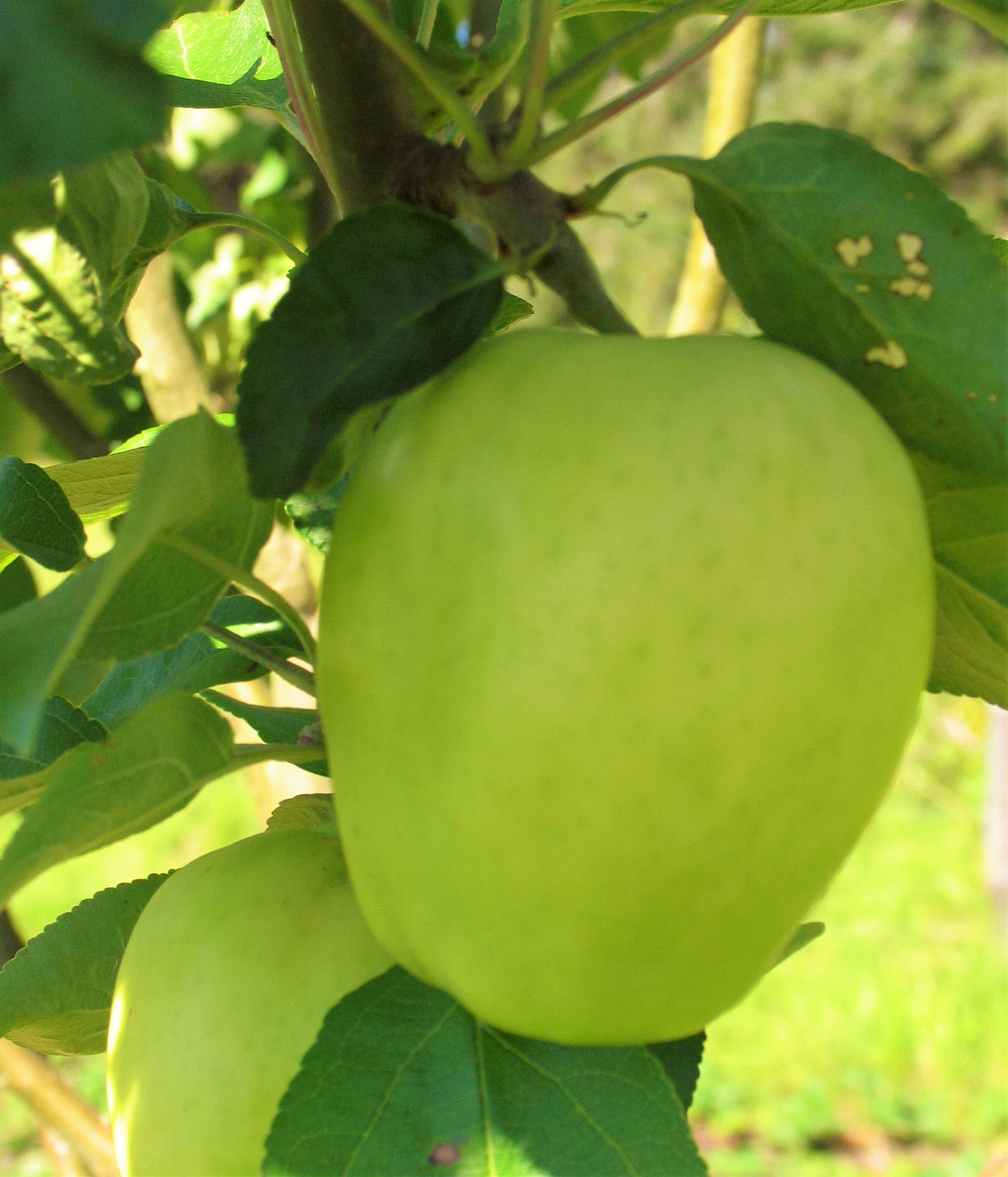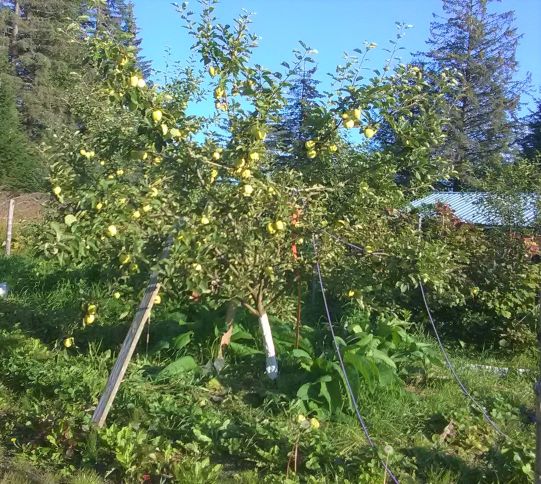Fruit Tree Care for SouthEast Alaska
A few thoughts on planting fruit trees by Larry Landry

We have learned that growing fruit trees takes a lot more than just sticking them in the ground. These are some tidbits from The Apple Grower by Michael Phillips, the go to guy for raising organic apples. I think it’s a safe guess that the same rules apply to cherries.
First big issue is where to plant. Good sun exposure is clearly important, but the big rub that looms large for our climate and flatness:
“Trees planted in saturated soils literally drown. Roots and trunk crowns deprived of good aeration fall victim to rot fungi. Marginal ground may not immediately cause a tree’s demise, but vigor will lack until a wet summer comes along to settle up the account”….”The groundwater table should not be higher than three feet during the growing season; if it is any closer to the surface, the tree’s submerged feeder roots can no longer function properly to feed the tree.”
Mound soil to raise the trees. Rob Bishop of Alaska Apple Farms in Hoonah mounds his three feet high and 3-4 feet across. That is of course a lot of soil and requires equipment. He says a couple feet high and across could still be a big help. Any slightly elevated or well drained areas on your land could make a big difference, but even then Rob suggests mounding them at least a foot high and a couple feet across to get the trunk off the ground, plus the mounds are helpful for long term care. Due to ignorance and soil limitations, we elevated most of ours only a few inches and they are fine so far, but make me nervous for the long haul.
Unless they are a dwarf or columnar variety, plant trees about 12 feet apart.
A thick carpet of grass right around your trees are not a good thing, so if you are planting in a lawn, remove the sod or cover it with cardboard when you plant. Keeping the grass at bay is a long term issue. The grass will rob nutrients from the tree.
It is best to plant as early in the spring as possible “after the soil has dried out sufficiently”. Don’t allow the roots to dry out before planting. They can be soaked in a seaweed solution to reduce transplant stress.
For bare rooted trees, the size of the hole needs to be large enough to accommodate the roots without bending them. It is better to prune back a real long root or dig a trench for it than curl it back on itself. The roots should radiate in all directions around the tree. Tamp the soil as you fill the hole to eliminate any air pockets.
Counterintuitively, don’t mix in a bunch of compost or rich earth in the planting hole—the roots will extend much further if a good food supply isn’t near at hand. Phillips backfills with the soil that came from the hole and adds one pound of black rock phosphate and nothing else. (Given our not very fertile soils, we add a little compost and wood ash, then lightly top dress with compost around the hole and mulch the area to suppress weeds.) Tree nutrition in future years will come from above to feed the top six inches of soil, where 90% of the feeder roots are found. And that should be it for fertility the first year. As a general rule, don’t feed the trees after mid-summer to encourage them to go dormant earlier in the fall—they are prone to keep their leaves on late, which can be a real problem when we get early snows.
It is helpful to sprinkle mychorrhizal fungi spores on the roots before you plant to help get those relationships established. Steller Botanicals sells this. I also add some soil from under alder and wild crab apple trees in the hopes of adding some native species.
Phillips puts a few inches of pea gravel out about a foot from the trunk to help keep it dry and suppress weeds. Rob says shells can also be used.
We learned the hard way that it is important to stake the trees for several years or they will tip in the wind. The leaves catch a lot of wind. We use three stakes to address different wind directions. Use a piece of old hose or bike innertube or strapping to protect the bark from rope abrasion and “strangling” the tree. I’ve too often found a compression in a trunk that I had tied with too narrow a piece of cord. I don’t know if it is necessary or not, but I remove the rope in the wintertime once the leaves have fallen to avoid creating a potential locus for infection given how much the bark will be wet. With the leaves gone the trees won’t fall over.

It is a good idea to put some ¼”hardware cloth around the tree trunk to keep voles away from the trunk—they will gnaw the bark. I think this is mostly for wintertime, but in a high vole year you never know. The trees will grow pretty fast, so leave room for trunk expansion.
Another thing we learned the hard way is that it’s important in the fall to paint the tree trunk white as far up as the first branch to prevent sun scald next spring. Reflected sun on the snow in the springtime can make sap run in the trunk prematurely, which can then freeze at night and damage it. Use a latex paint diluted 50-50 with water. I don’t know if this is needed in a hoophouse where there won’t be snow.
And lastly, it is important to keep them well watered if we get a dry spell.
You will want to prune your trees soon after they are planted. There are some good youtube videos on pruning young trees. Our ritual has been to prune and then spray with neem oil after. As neem can help protect trees, plants and soil from pathogens.
And of course, we live in rural Alaska with bears and moose wandering through our yards which means delicacies like fruit trees must be protected from both. Moose need a fence 6' tall or that appears wide enough they can't just jump directly over it. Moose will go right through an electric fence (ask us how we know!). When we lived in Interior Alaska we had a fence that was 6' high then attached little outrigger pieces of wood to the frame posts that held a large piece of rope that we then wrapped around the garden, this made our fence look wider than it truly was. Over the years as our fence aged, it got to the point a moose could have probably knocked over the fence but we never had a moose get in the garden. And for bears you will need to put lines of electric fencing around your fencing to keep bears away from trees that are bearing fruit.
